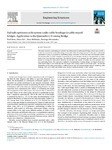Fail-safe optimum cable system under cable breakage in cable-stayed bridges. Application to the Queensferry Crossing Bridge

Ver/
Use este enlace para citar
http://hdl.handle.net/2183/32800
A non ser que se indique outra cousa, a licenza do ítem descríbese como Atribución-NoComercial-SinDerivadas 3.0 España
Coleccións
- CITEEC-ME - Artigos [28]
Metadatos
Mostrar o rexistro completo do ítemTítulo
Fail-safe optimum cable system under cable breakage in cable-stayed bridges. Application to the Queensferry Crossing BridgeData
2023Cita bibliográfica
Soto, N., Cid, C., Baldomir, A., & Hernández, S. (2023). Fail-safe optimum cable system under cable breakage in cable-stayed bridges. Application to the Queensferry Crossing Bridge. Engineering Structures, 279, 115557. https://doi.org/10.1016/j.engstruct.2022.115557
Resumo
[Abstract:] This paper presents a methodology to optimize the cable system in cable-stayed bridges, whose main novelty is to take into account the accidental breakage of one cable within the design process. To this end, a multi-model optimization strategy is proposed by establishing design constraints on both the intact and damaged models. The dynamic effect of cable breakage is accounted for in the damaged models by the application of impact loads at the tower and deck anchorages. The objective function is to minimize the steel volume in the cable system by varying the cable anchor positions on the deck, the number of cables, the cross sectional areas and prestressing forces. This approach is applied to the Queensferry Crossing Bridge, the longest three-tower cable-stayed bridge in the world and also the largest with crossing cables in the central spans. The fail-safe optimization of the cable system leads to a different layout than the optimum design without considering cable breakage, with more cables and smaller areas, having a minimum penalty in steel volume.
Palabras chave
Cable-stayed bridge
Optimum design
Fail-safe
Cable breakage
Crossing cables
Optimum design
Fail-safe
Cable breakage
Crossing cables
Descrición
Financiado para publicación en acceso aberto: Universidade da Coruña/CISUG
Versión do editor
Dereitos
Atribución-NoComercial-SinDerivadas 3.0 España






